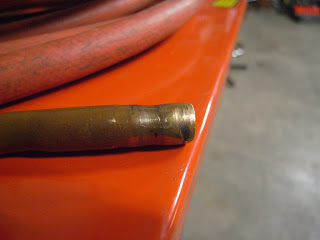FINALLY! Some progress other than moving from one place to another. heh
I started out by taking out the radiator and fan:
Yes, that is a real Flex-a-lite fan. As you can see the fan guard "self-clearanced" with the hot downpipe (which I never got around to wrapping) and needed a new mounting bracket made for the bottom of the fan due to heat damage and how the radiator was emplaced. (Again, I didn't do that. heh)
Radiator out!
Hacked to death radiator support:
Front shot:
My very first downpipe:
That is a legit 3" downpipe on a T25. It's rusty now, but it has survived a heck of a lot. There are some improvements I think I can make to it eventually, but for now, it will stay just as you see it.
Another closeup of the lines that I ran hastily:
I honestly hate braided stainless steel lines. They are extremely abrasive and if left to vibrate around can easily eat their way through anything, including belts, wires and even engine blocks! (That is not conjecture. I've seen SS braid eat through an iron block V8.) The copper line is a compromise in using was is available at the time. It works perfectly well, as it isn't under much tension or stress, but over time, it WILL break or crack due to work hardening from vibration and heat cycling. It will be replaced and the lines overall will be run in a cleaner and more efficient manner.
On to the next task: fitting the intercooler! "EFs" are notoriously difficult fit FMICs (front mount intercoolers) because of this:
That is the front bumper support. It fits across the whole front to provide structure in the event of a crash, and due to how low the front of all 88-91 Civics are, the bumper support inconveniently lies right where most people want to put an intercooler.
The other part of the issue is that the bottom of the bumper support has this lip that was made for the convenience of pinch-welding the pieces together at the factory. Here's a closeup of the lip:
A few minute with an angle grinder and a cut off disc and flap wheel and this is what you get:
Once I get my sheet metal brake (bender) set up, I will be bending up some sheet to cover the gap and provide more structure for mounting the intercooler to the underside of the bumper support, something like this:
I have some pretty clever ideas on how to actually mount the intecooler, which, of course you will see after I develop the ideas further and put them into action.
























